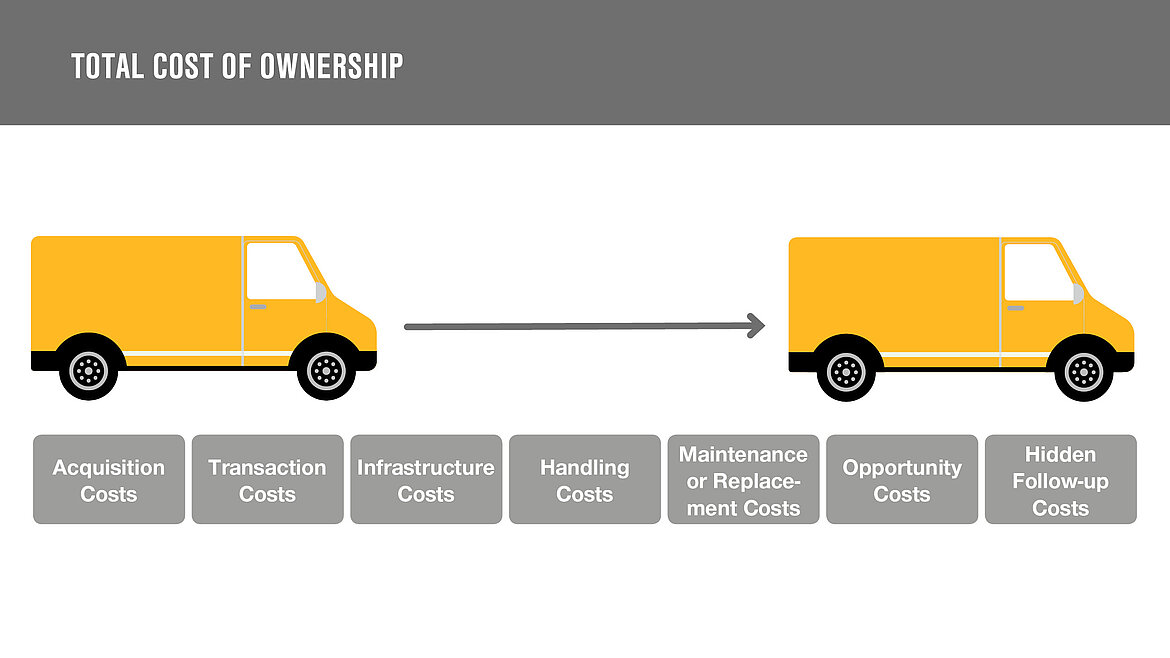Cost Analysis for Last Mile Vehicles with GRP Bodies
Only two of many concepts for cost analysis are Total Cost of Ownership (TCO) and Life-Cycle-Costing (LCC). These two terms are often used synonymously, but they describe quite different cost perspectives on products or services. This article explains the two perspectives of cost analysis for Last Mile vehicles with GRP bodies.
Total Cost of Ownership

Total Cost of Ownership considers the total cost of a product or service from the time of purchase. The key feature: This makes the actual costs between the providers transparent and comparable. So, those who initially only pay attention to the cheapest purchase price may wonder after a TCO analysis: In the overall assessment, another provider usually wins.
In our example, we assume a fleet operator who purchases a Last Mile vehicle for his fleet. Before deciding on a manufacturer and a vehicle, he considers seven cost areas with the Total Cost of Ownership model over the total ownership period of his transporter:
1. Acquisition costs
The purchase price or leasing cost is the first and most obvious amount to be included in the TCO calculation. Prices vary significantly depending on the materials, equipment and manufacturer brand used. Especially in this cost block, the inexpensive offers entice you to buy. This may look different after point seven.
2. Transaction costs
This includes all aspects of financing such as leasing fees or depreciation costs. Handling costs such as vehicle transfer, transport or insurance are also included here.
3. Infrastructure costs
In this cost block, the fleet operator calculates everything that serves to maintain the vehicle, such as fuel, lubricants and coolants as well as other vehicle fluids. However, the fleet operator must not only consider supplying the vehicle with these resources, but also their disposal costs. If his Last Mile Transporter has an electric motor, the electricity costs are estimated. The trend topic of lightweight construction comes into play here: A lighter vehicle saves fuel or enables increased payload weight. And the lighter the Last Mile vehicle itself is, the sooner you can drive it with a normal class B car licence - which reduces personnel costs. With such setups, the offers quickly become significantly different. Last Mile vehicles with GRP bodies stand out in particular: Their lightweight construction potential earns them some advantages in infrastructure costs.
4. Handling costs
This includes the activities and costs incurred by the fleet operator himself to integrate the vehicle into the fleet, such as the construction of an additional garage, the integration into day-to-day business or the training costs for employees. Of course, these costs should also be kept as low as possible. GRP can also help here: For a modular garage. LAMILUX TextureWall fibre-reinforced composite is used instead of a plaster facade on the outer walls. It is easier to apply, more resistant to UV rays and weathering than plaster, has the same appearance, stays beautiful for longer and can even withstand those occasional moments when parking in the garage is not entirely successful.
5. Maintenance or Replacement Costs
These are the typical repair, maintenance and repair costs on the vehicle. On the one hand, those that are regularly incurred, but which differ significantly depending on the vehicle type and brand, i.e. customer service, for example. On the other hand, the fleet operator also calculates replacement costs for the usual wear parts. And another point comes into play in this cost block: If the purchased vehicle has hidden defects or if it is constructed from materials that are not fit for purpose, it quickly adds up to a horrendous sum. This rarely offsets an inexpensive purchase price. A lot can be saved here with external walls and interior cladding made of GRP. The material itself is so robust and impact-resistant that it really takes some beating before anything fails. And even then, repairs can be carried out either partially or comprehensively simply and cost-effectively. The downtime of the vehicle is thus minimized many times over.
6. Opportunity costs
If the vehicle does not meet all the requirements created by the fleet operator exactly, the profits to be recovered from this will be reduced. For example, if the transporter has a diesel engine and therefore cannot be used in certain districts, precisely these opportunity costs are incurred.
7. Hidden Follow-up Costs
This is the most inaccurate cost block to calculate. It relates to the consequences that the use of the Last Mile vehicle may have for the fleet operator. For example, if it is very loud, it emits many pollutants or if it has serious visual damage after a short time, this has a significant effect on the image of the entire fleet. This can go so far that the company's core competence – the fast, reliable and safe transport of goods over the last mile – is questioned and customers lose confidence in this fleet. As a result, orders are less frequent and economic damage is predestined.
But the opposite can also be the case: Instead of producing hidden costs, the vehicle can also have an image forming effect – for example because it is a light, low-pollutant e-vehicle or because it complies with PIEK noise protection standard, particularly during the night hours.

Does this also remind you of your grandma saying " buy cheap, buy twice“? Or perhaps she said, "We can't afford to buy cheap things." Taking the Total Cost of Ownership method as a basis for this popular wisdom, some truth quickly becomes apparent:
Ultimately, what the Last Mile Vehicle really costs the fleet operator, how quickly it pays for itself and how much internal expense the company has to incur for this can only be seen after taking an integrated approach to the seven categories described above.
Life-Cycle-Costing

Unlike TCO, the Life-Cycle Costing model considers costs over the entire service life of a product or service. This begins well before the purchase of the Last Mile vehicle, namely during its planning, development and production phase at the vehicle manufacturer. This is followed by the actual phase of use or also the market phase for the fleet operator. After the vehicle has been scrapped, the follow-up phase begins, where disposal costs, such as recycling, accumulate. This integrated approach describes the economy as an integrated product life-cycle. Individual cycles can also be broken down within the life cycle model, such as a project life-cycle, a supplier life-cycle or a fleet life-cycle.
Life-cycle costing therefore pursues several goals: For the vehicle manufacturer, it is a conclusive way of collecting well-founded sales and marketing arguments. Conversely, the fleet operator can make an integral comparison of competitors vehicles. In both cases, life-cycle costing also analyses the cost-effectiveness of the Last Mile vehicle, which shows both the manufacturer and the user potential for optimization.
Variables taken into account here are obvious costs on the one hand, such as the annual sum insured for the Last Mile vehicle. On the other hand, however, are also the aspects of time and performance. For example: How intensive is the care and cleaning of the vehicle? Or in fact: Into which areas of the company's activity can the fleet operator integrate the vehicle?
One reason for the vehicle manufacturer to use this method is the justification of any higher acquisition costs. If he compares this to the other phases of the integrated product life cycle, they usually relate to each other. Another striking example of this:

If the manufacturer uses glass-fibre reinforced plastics (GRP) as construction materials for the box body of the Last Mile vehicle, this can be more expensive than aluminium. However, if the aluminium sheets are coated or painted, the costs will also increase. In addition, the plastic panels are much more robust and can withstand impacts, hail storms or scratches from trees better.
As a result, the manufacturer can issue a longer warranty and the fleet operator has less vehicle downtime due to repairs. For motor homes, insurance can even be discounted if the roof is made of GRP and is therefore hail-resistant.

